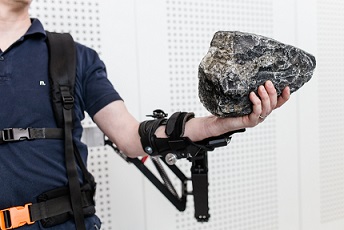A robot suit to help industrial workers

date: 02/07/2015
Project: Intelligent exoskeleton based on human-r...
acronym: ROBO-MATE
See also: CORDIS
In factories and processing plants all over Europe, people lift, carry and handle heavy loads as part of their job. Frequently moving heavy loads leads to work-related problems such as lower-back pain and injuries to arms and legs.
“A lot of workers suffer from these musculoskeletal disorders, and this is what we want to avoid,” says Hans Wernher van de Venn, Head of the Institute of Mechatronic Systems (IMS) at the Zürcher Hochschule für Angewandte Wissenschaften (ZHAW).
“The goal of Robo-Mate is to develop a user-friendly, and intelligently cooperative, wearable lightweight human-robotic exoskeleton for manual handling work,” explains van de Venn, the project coordinator.
Robo-Mate has designed an exoskeleton with a fully movable upper body and powered supports for arms. To begin with, electrical power can be supplied to the suit’s motors from ceiling-mounted cables – but the group also aims to develop a more mobile battery-powered version that will be charged via power cables while working at different sites in order to keep it lightweight.
“We are not building a super-hero suit,” emphasises the professor. “It’s more like an active version of a weightlifter’s support belt.”
Back-breaking work
Workplace injuries already cost European countries up to 4% of GNP, and more than a quarter of Europeans experience back injuries due to work. Robots are taking some of the strain, although they still tend to be too inflexible for many manual handling tasks.
“In car recycling, for example, we find people working eight-hour shifts, moving up to 7 km during the day, and carrying a cumulative weight of up to 4 tonnes,” continues van de Venn. “They need support for this strain on their bodies, especially as we see a shift towards an older generation of workers.”
Ageing populations have led to a rise in retirement age. Older people often bring extremely useful experience to the workplace but they need help if they are going to do any kind of physical work into their 50s and 60s. Younger people also need supports to avoid injuries that could harm their health and employability later.
“We are focusing on supporting workers who need to hold different positions – such as working in overhead situations in the car or air industries,” explains the professor. “The aim is simply to offer support for workers who regularly have to lift weights in the range 7 to 15 kg. Above 20 to 30 kg, industry tends to use robots and manipulator arms.”
The suit is designed to include a human-machine interface (HMI) and cognitive intelligence, as well as the mechatronic supports to arms and back. This will enhance the wearer’s perception in their industrial environment as well as increasing their apparent strength.
Safety first
The system uses sensors to recognise the objects the operator is moving – not only for the motors to supply the correct force to the user’s arms to support lifting, but also to limit gripping forces and decrease the risk of damage.
Sensors in the exoskeleton detect what the user wants to do – if they lift their arm, the suit copies the movement and adds power to it – but they also give warnings when other robots and industrial machinery are near. All this is complemented and controlled by a heads-up display for the operator to see what is going on.
“Of course, one of the main topics of the research is safety,” van de Venn continues. “We analyse the potential injuries and advise on fail-safe systems to avoid them, such as limits to the force exerted by the supports.”
The first prototype, comprising modules for the arms and trunk of the body, was unveiled in June 2015.
The annual world robotics market is set to double to US$66 billion (more than €60 billion) over the next 15 years. By developing innovative, tailored solutions like the Robot-Mate powered suit, Europe could take the lead in collaborative industrial applications – a big part of that potential market.
